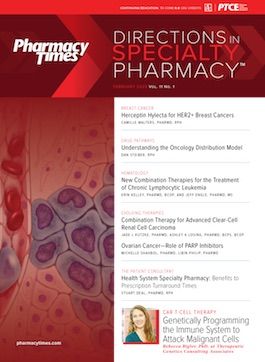Publication
Article
Specialty Pharmacy Times
Guselkumab Shows Efficacy as Active Psoriatic Arthritis Treatment
Author(s):
Data from 2 studies evaluating guselkumab (Tremfya, Janssen) in active psoriatic arthritis were presented at the American College of Rheumatology and Association of Rheumatology Professionals 2019 Annual Meeting.
Guselkumab (Tremfya, Janssen) demonstrated positive results as a treatment in patients with active psoriatic arthritis (PsA), according to new findings from 2 phase 3 studies.
These data, which are from the DISCOVER-1 and DISCOVER-2 studies, were presented as part of an oral plenary session and a late-breaking poster session, respectively, at the American College of Rheumatology and Association of Rheumatology Professionals 2019 Annual Meeting.
Guselkumab, an interleukin-23 (IL-23) p19 subunit inhibitor, is approved by the FDA for the treatment of adults with moderate-to-severe plaque psoriasis who may benefit from systemic therapy or phototherapy.
DISCOVER-1 is an ongoing phase 3 study evaluating the efficacy and safety of guselkumab administered by subcutaneous injection in 381 patients with PsA, including those previously treated with biologic antitumor necrosis factor alpha agents, continuing through approximately 1 year. The study consists of a screening phase up to 6 weeks, a blinded treatment phase of 52 weeks, and an active treatment period from week 24 to week 52, as well as a safety follow-up phase of 8 weeks after week 52.
Results from DISCOVER-1 showed that, at week 24, 59% of patients with active PsA receiving guselkumab every 4 weeks (q4w), and 52% of patients receiving guselkumab at weeks 0, 4, and every 8 weeks thereafter (q8w) achieved an ACR20 response. This was compared with 22% of patients receiving placebo, according to the study. The data also showed that, among patients who had a ≥3% body surface area (BSA) affected with psoriasis and an Investigator Global Assessment(IGA) score of ≥2 at a baseline, 75% of patients receiving guselkumab q4w and 57% of patients receiving guselkumab q8w achieved an IGA score of 0 or 1 and a ≥2 grade reduction, compared with 15% of patients receiving placebo.
In DISCOVER-2, guselkumab is being evaluated in 739 patients with active PsA, continuing through approximately 2 years.
At week 24 of the DISCOVER-2 study, 64% of adult, biologic-naïve patients with active PsA receiving guselkumab q4w or q8w respectively, achieved an ACR20 response compared with 33% of patients receiving placebo. Additionally, among patients who had a ≥3% BSA affected with psoriasis, and an IGA score of ≥2 at baseline, 69% receiving guselkumab q4w and 71% receiving guselkumab q8w achieved an IGA score of 0 or 1, and a ≥2 grade reduction from baseline, compared with 19% of patients receiving placebo. Patients with active PsA receiving guselkumab q4w showed significantly reduced radiographic damage progression versus placebo week 24, according to the study.
Observed adverse events in both studies were generally consistent with previous studies of guselkumab and current prescribing information.
“People living with psoriatic arthritis cope with symptoms like pain, joint swelling, and irreversible joint damage that may interfere with their daily activities,” Atul Deodhar, MD, MRCP, FACP, FACR, professor of medicine at Oregon Health & Science University and study steering committee member, said in a statement. “These data show Tremfya as a potential treatment option to help patients living with this serious disease.”
Data from the DISCOVER program was used to support the supplemental Biologics License Application submission to the FDA for the approval of guselkumab in active PsA.
REFERENCE
Tremfya (guselkumab), a First-in-Class IL-23 p19 Subunit Inhibitor, Meets Primary Endpoints of Superior ACR20 Responses versus Placebo at Week 24 in Phase 3 Psoriatic Arthritis Studies [news release]. Janssen’s website. https://www.janssen.com/tremfya-guselkumab-first-class-il-23-p19-subunit-inhibitor-meets-primary-endpoints-superior-acr20. Accessed November 19, 2019.







